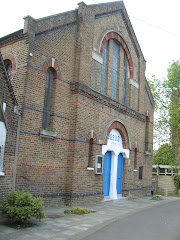The district now known as Childs Hill formed part of the ancient Manor of Hendon with which St Dunstan, Archbishop of Canterbury (d 988), endowed the Abbey of St Peter at Westminster in 959. In 1150 Abbot Gervase de Blois (illegitimate son of King Stephen) gave the land away. By 1295 the land was in royal hands again until Edward I gave it to Westminster Abbey as soul alms for his dead queen, Eleanor. In 1316 the Abbey exchanged the land for the Manor of Hodford and later in the same century Sir Richard le Scrope, 1st Baron Scrope of Bolton, some time Lord Chancellor, held them before exchanging them with Richard II for lands in Yorkshire. Hodford and Cowhouse were again ceded to Westminster Abbey in soul alms for Richard and his first wife Anne of Bohemia, in 1399. At the dissolution of the monasteries in 1550 the property came to the shortly-lived Bishopric of Westminster and from there into the hands of the Ecclesiastical Commissioners via the Dean and Chapter of Westminster.
Two other dates worth mentioning are 1301 when Richard de Gravesend (Bishop of London) granted Walter de Wenlock (Abbot of Westminster) licence to celebrate ‘Divine service’ in the chapel which the monks of Westminster had built on their Manor of Hodford, provided that the consent of the Rector of Hendon be first obtained.
Then in 1321 The Black Book of Hendon included the name of Richard Child. It is from the Child family that Childs Hill derives its name.
Thus from quite early times Childs Hill was subject to the attentions of professing Christians. Sadly the state of the Mediaeval church was such that one wonders if any peasants in the area would have heard the gospel from the monks. We do not know, but God knows and one day in Heaven may be we will find that even in ancient times God had a people in this same area.
Two other dates worth mentioning are 1301 when Richard de Gravesend (Bishop of London) granted Walter de Wenlock (Abbot of Westminster) licence to celebrate ‘Divine service’ in the chapel which the monks of Westminster had built on their Manor of Hodford, provided that the consent of the Rector of Hendon be first obtained.
Then in 1321 The Black Book of Hendon included the name of Richard Child. It is from the Child family that Childs Hill derives its name.
Thus from quite early times Childs Hill was subject to the attentions of professing Christians. Sadly the state of the Mediaeval church was such that one wonders if any peasants in the area would have heard the gospel from the monks. We do not know, but God knows and one day in Heaven may be we will find that even in ancient times God had a people in this same area.




